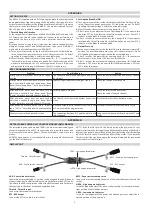
THRUSH AIRCRAFT, INC – MODEL S2R-R1340
AIRCRAFT MAINTENANCE MANUAL
2-6
Effective 01/01/08
Locating the aircraft inside a heated
hanger is the most effective method of
preheating the aircraft. The use of an
external power unit is recommended to
conserve the battery.
COLD WEATHER MAINTENANCE
HINTS
The information that follows is intended
only for the purpose of supplementing the
existing information in this manual when
operating the aircraft in very cold weather.
Keeping the aircraft in top maintenance
condition during cold weather cannot be
over stressed.
BATTERY:
The battery should be
maintained at full charge during cold
weather to prevent freezing. After adding
water to the battery in freezing
temperatures, charge the battery to mix
the water and electrolyte. A frozen battery
may explode when subjected to a high
charge rate. Corrosive damage to the
area adjacent to an exploded battery will
result if the electrolyte solution is not
removed immediately. Instructions for
removing spilled electrolyte are provided in
this Section. The battery should be
removed and stored in a warm place if the
aircraft is to remain idle for an extended
period of time.
FUEL SYSTEM:
In the fuel system,
condensation is more likely to occur in cold
weather due to a more rapid and positive
division of moisture content from other fuel
constituents. If at all possible, use fueling
facilities that filter moisture from the fuel. If
fueling facilities with filters are not
available, filter the fuel through a good
quality chamois. Fill the tanks with correct
grade of fuel as soon as possible after
landing to reduce the possibility of
condensation and ice formation in the
tanks. Fuel extracted from fuel header
tank drain before starting deserves a
closer examination when the aircraft is
being operated in cold weather.
POST FLIGHT MAINTENANCE:
Cold
weather operation demands procedures
that are in addition to normal Post Flight
Maintenance Procedures. Fill the fuel
tanks immediately after flight. If shelter is
not available, tie the aircraft down and
install covers on all vents, openings, etc.
as required.
GROUND EMERGENCY
PROCEDURES
Emergency procedures must be
accomplished as rapidly as possible,
should an emergency arise. It is
suggested that steps pertaining to each
emergency be committed to memory in
order to accelerate the procedure and
minimize any possible damage.
ENGINE FIRES
If a fire develops in the engine area during
engine start, continue to attempt to start
the engine in an attempt to blow the fire
out. If the fire persists, proceed as follows:
a. Mixture Control - Idle Cut Off
b. Starter Switch - Off
c. Master Switch - Off
d. Fuel Shutoff Valve - Off
e.
Abandon the aircraft
ELECTRICAL FIRES
Circuit breakers will automatically trip and
stop the current flow to a shorted circuit.
However, as a safety precaution in the
event of an electrical short circuit or fire,
turn the battery switch to
off
. Use a fire
extinguisher approved for electrical fires to
extinguish any flame. Do not leave the
aircraft unattended so long as there is any
evidence of fire or hot spots.
GROUND OPERATION OF ENGINE
Reference Section 4
Perform all engine ground operations with
the mixture control in FULL RICH position
and the propeller control in HIGH RPM














































